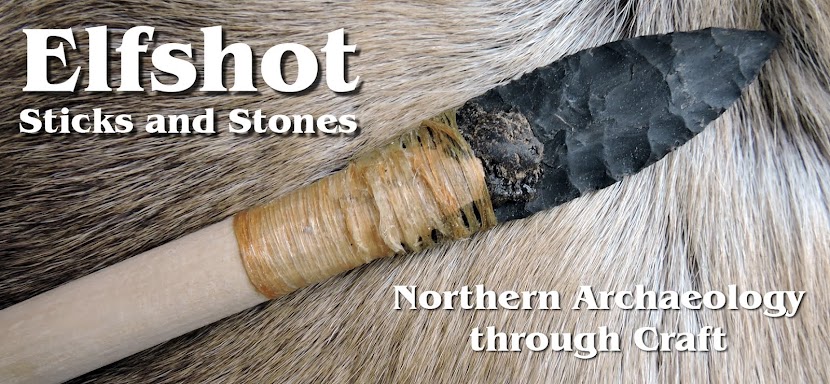Friday, June 28, 2013
Wednesday, June 26, 2013
Scruffy time of year
Monday, June 24, 2013
Friday, June 21, 2013
Purple Saxifrage
Wednesday, June 19, 2013
Seal Breathing hole drains
 |
| Some of the bays and inlets are full of the holes and channels. |
 |
| They can be quite stunning from the air on a sunny day. |
 |
| In this photo, you can see a dot on the ice next to the drain. That's the seal who maintains the hole, up for a bit of sun lying out on the ice. |
 |
| This is the same drainage system as the above shot with the seal. You can see a bit of dirty ice where the seal hauls up and how big of an area drains through the hole. |
 |
| Not as complex a drainage system, but the hole through the ice is pretty clear in this shot. |
Monday, June 17, 2013
Groswater Palaeoeskimo Lithic Artifacts
Friday, June 14, 2013
Groswater Palaeoeskimo Endblades
Wednesday, June 12, 2013
Tracking Elfshot Artifact Reproductions, Part 2
 |
| Harpoon heads |
 |
| Harpoon heads and art on display in Cambridge Bay |
 |
| In this case, I made the whip and the dog muzzle sitting in the lower right foreground. |
Photo Credits:
1) Screen capture from 3DS Kitikmeot Portfolio http://3dservices.com/portfolio/kitikmeot-artifacts
2,3) Screen captures from Google Streetview https://maps.google.ca/help/maps/streetview/gallery/arctic/kitikmeot-heritage-society.html
Monday, June 10, 2013
Tracking Elfshot Artifact Reproductions, Part 1
 |
| Sealskin whip with antler handle |
From the 3DS portfolio page on the project:
The society commissioned 3DS to replicate a series of ancient tools, once used in everyday life. The resulting “hands-on” experience provides young Inuit visitors with a sense of connection that would be impossible with conventional means. 3DS worked from photographs of the actual items, creating museum-grade replicas of authentic Inuit tools, such as sealskin knives, spears, drums, lamps and harpoons. We made two sets: For the first, displayed in a closed exhibit under protective glass, we used the very same materials used by the Kitikmeot ancestors. This allowed us to create absolutely authentic, completely functional replicas, indistinguishable from the ancient originals. The second set looks identical to the first in every way – until you touch them: we substituted all cutting blades with a hard rubber compound, making everything completely safe for direct handling.
The finished exhibit was extremely well received. Our client said, “it brought tears to my eyes to see young people learning the old ways with real, authentic tools”.
 |
| The painted drum |
I haven't visited Cambridge Bay since the pieces were installed, but I did find an unexpected way to tour the installation that I'll share in a future blog post.
Photo Credits: Screen captures from 3DS Kitikmeot Portfolio http://3dservices.com/portfolio/kitikmeot-artifacts
Friday, June 7, 2013
Rhyolite Knapping for Burnside
 |
| My production knapping kit |
 |
| Future necklaces and earrings |
Photo Credits: Tim Rast
Wednesday, June 5, 2013
Newfoundland and Labrador Archaeological Society, Inc.
 |
| Follow @NLArchSociety on Twitter! |
Newfoundland and Labrador Archaeological Society Mission Statement:
To promote an understanding of archaeology in Newfoundland and Labrador and protect archaeological resources by fostering research, stewardship, education, and the exchange of ideas and information between professionals and the public.
 |
| Share and view photos of artifacts and sites in Newfoundland and Labrador on Facebook. |
 |
| Browse the photo albums on Facebook |
- Summer 2013: Develop and approve an NLAS Constitution and Code of Ethics
- Fall 2013: Hold elections, public planning meetings and begin a membership drive
- Winter 2014: Seek Charitable status
- Spring 2014: Apply for Cultural Economic Development Program (CEDP) funding from the Provincial Government.
As we progress through the dry mechanics of creating the society, we will be developing interesting content and services for members along the lines of public lectures, workshops, demonstrations, newsletters, education campaigns, etc, so look for those to start rolling out over the fall and winter as well. At this point we invite you to Like us on Facebook, follow us on Twitter and give us your suggestions on how a Newfoundland and Labrador Archaeological Society can help you. What services or events would you like to see the NLAS offer?
 |
| What sites will you visit this summer? |
Like NLAS on Facebook: https://www.facebook.com/NLArchSociety
Follow NLAS on Twitter: https://twitter.com/NLArchSociety
Photo Credits: Screen Captures from the Newfoundland and Labrador Archaeological Society Facebook Page.
Monday, June 3, 2013
Ralph Pastore Pioneers Scholarship 2013
 |
| Dr. Ralph Pastore |
In 2007, Amina awarded its first Pioneers Scholarship, which was named in honour of Elmer Harp to Matthew Walls, a graduate student who completed an MA at the University of Calgary and moved on to a PhD at the University of Toronto where he is studying qayaqs in Northern Canada and Greenland. The Amina directors are working towards making the Pioneers Scholarship an annual award which will be named to recognize researchers who have made important contributions in the field of archaeology and distribute those funds to new archaeologists at the start of their careers. The current scholarship recognizes Ralph Pastore, a Historian and Archaeologist dedicated to uncovering the story of Newfoundland's Beothuk people. The funds for the Pastore Scholarship were raised through contributions from Ralph’s brother John, sisters Kathleen Miller and Mary Ann McClain, as well as Tom Campbell and Mary Mogford of Newcastle, Ontario, Amina Anthropological Resources Association, and Adventure Canada.
 |
| Ralph Pastore at Boyd's Cove, NL |
The deadline for application for the scholarship is September 15, 2013 and the $1400 award will be dispersed to the successful applicant in December. Applicants must be MA or PhD students researching a topic in Newfoundland and Labrador Archaeology. Application details are available on the Amina website here.
Photo Credits:
1,3: Photos from www.aminainc.org courtesy of Laurel Doucette
2: Screen capture from www.aminainc.org
Subscribe to:
Posts (Atom)













